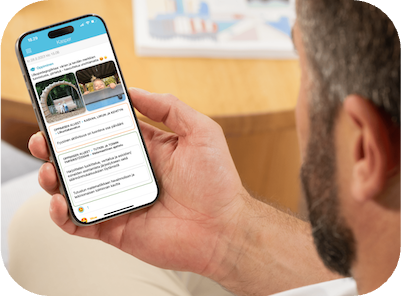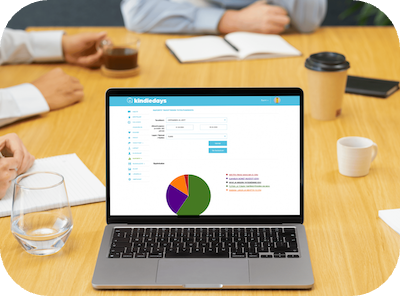Part 1 of 7
This time, we are delighted to publish a guest post series by Ranjan Goyal, one of the leading experts in preschool education. As the CEO, Ranjan has set up several preschool chains in India. He is now an independent consultant helping preschools address new needs and opportunities, and he shares his advice on this topic here.
Guest Post from Ranjan Goyal

Ranjan and the Ambassador of Finland to India, Kimmo Lähdevirta.
"I am planning to set up my own premium preschool in India. What advice can you give me?"
This is the most frequently asked question I receive, and it typically leads to an engaging discussion. Setting up a premium preschool in India can be highly profitable, but it is crucial to strike a balance between educational quality, business sustainability, and meeting parent expectations. Let me give you an idea of what to be careful about:
1. Define Your Vision and Market Positioning
- Have a clear vision: Decide if you want to be known as a progressive preschool (focused on play-based, inquiry-led learning), an academic readiness preschool (emphasizing preparation for primary school), or a holistic development preschool (blending academics, life skills, and well-being).
- Premium positioning: In India, "premium" often means international pedagogy/ curriculum, safe infrastructure, and parent engagement. Make sure your value proposition is clear.

2. Curriculum & Pedagogy
- Take a trusted framework: Many premium preschools in India are influenced by philosophies from Finland, Montessori, Reggio Emilia, or IB Early Years. Parents associate these with modern, high-quality education, which keeps pace with the changing times.
- Align with NEP 2020: India’s new National Education Policy (NEP 2020) strongly emphasizes play-based, activity-based, and inquiry-based learning. Position your preschool in alignment with the NEP—it reassures parents as well as local regulators.
- Balance academics & play: Most parents in India want school readiness (reading, writing, numeracy), but premium parents also value creativity, confidence, thinking skills, and problem-solving. Therefore, adopt a blended approach rather than focusing solely on one versus the other. Remember, you are educating children for a life that will be pretty different from what we know.
3. Infrastructure & Environment
- Location: Select a safe, accessible neighbourhood with proximity to mid- to high-income families.
- Design & layout: Spacious, bright, and child-safe interiors with learning corners, outdoor play areas, child-sized furniture, and paints & other materials easily accessible to children. Parents are impressed by a warm and aesthetically pleasing environment.
- Safety & hygiene: CCTV monitoring (for safety purposes only), biometric access, child-friendly washrooms, and clean food preparation areas are now expected in premium preschools.

4. Teacher Quality & Training
- Recruit carefully: Passionate, nurturing teachers are your best brand ambassadors.
- Continuous training: Offer training workshops to upgrade teaching skills in early years pedagogy, parent communication, and child observation. These are now available from Nordic countries such as Finland, which have a global reputation for high-quality preschools. Better-trained teachers are less likely to leave the school easily, which helps build parent trust and a positive reputation.
- Ratio & class size: Maintain a low teacher–child ratio (1:10 or 1:12) to differentiate your preschool as a premium option.

5. Parent Engagement
- Transparency: Parents expect daily updates, photos, and evidence of learning. Easy-to-use digital tools can help. These are now readily available from education companies based in Finland and India. The best part is - they are affordable.
- Community building: Conduct parent workshops, family days, and counseling sessions.
- Two-way communication: Indian parents want to feel involved in their child’s progress. Utilize technology to construct this without wasting the teacher’s time. This motivates teachers.

6. Marketing & Branding
- Brand story: Build a narrative around international best practices, holistic learning, and nurturing values.
- Local relevance: Blend modern pedagogy with cultural familiarity (festivals, regional songs, value education).
- Digital presence: A strong website, an active Instagram account, and regular WhatsApp updates are essential.
- Word of mouth: The strongest driver—delight your first 30 parents, and they’ll bring in the next 100. Word of mouth primarily comes when parents trust the school (thanks to the learning updates they receive on their mobile app) and see stable, loving teachers who don’t leave.

7. Business & Operations
- Fee structure: Premium preschools in metro cities charge between ₹1.5 lakh and ₹ 4 lakh annually, depending on location and facilities.
- Revenue streams: Consider after-school programs, holiday camps, and teacher training workshops to maximize income.
- Franchise vs. independent: Decide whether to build your own brand or partner with an existing preschool chain. Independence offers freedom and early profitability, while franchising provides brand recognition.
- Compliance: Ensure you meet local childcare safety regulations, conduct staff background checks, and fulfill licensing requirements.

8. Technology Integration
- Digital classroom tools: Use apps for lesson planning, tracking child development, and sharing updates with parents.
- Learning management: Specific platforms from Finland can now support child portfolios, assessments, and parent communication.
- Future-readiness: Highlight how your preschool prepares children for 21st-century skills.

9. Stand out in a crowded market with a "Premium" position
- International pedagogy adapted to the Indian context
- Teacher excellence through training
- Daily parent engagement with evidence of learning – using a relevant mobile app
- Safe, aesthetic campus with outdoor learning spaces
- Holistic development (arts, mindfulness, sustainability practices)

10. Long-term Vision
- Scaling up: Once successful, you can expand into multiple centers or even a primary school.
- Reputation building: Invest in quality over speed—premium preschools grow best through parental trust, not mass advertising.
- Impact: A well-run premium preschool not only helps children but also upgrades teacher standards in the community. Thereby helping the nation.
What next?
In the following guest blog post, Ranjan will help you make a Business Plan for Your New Preschool. Don't miss it.
👉 In the meantime, join our Free Webinar about the "Strengths of Finnish Education" on October 4th. Check the invitation from Kindiedays on LinkedIn!
Team Kindiedays
--------------------------------------------------------------------------------------------------------------------
Kindiedays blog series to start a preschool
Kindiedays blog series to start a preschool
If you’ve been following our blog series, you now have a complete toolkit:
Part 1: How to Set Up a Preschool?
Part 2: Business Plan for a Premium Preschool in India
Part 3: Action Plan for Launching Your Preschool for Next Term
Part 4: How Visionary Owners Are Leading the Change
Part 5: Change Management Process
Part 6: Quality Assured Learning - The Competitive Edge
Part 7: How to Select a Curriculum Partner for Your Preschool
Many thanks to Ranjan for sharing his experience!
.png)